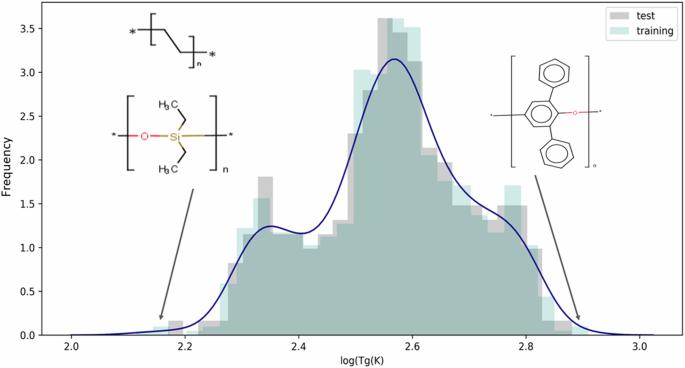Machine learning analysis of a large set of homopolymers to predict glass transition temperatures
IF 5.9
2区 化学
Q1 CHEMISTRY, MULTIDISCIPLINARY
引用次数: 0
Abstract
Glass transition temperature of polymers, Tg, is an important thermophysical property, which sometimes can be difficult to measure experimentally. In this regard, data-driven machine learning approaches are important alternatives to assess Tg values, in a high-throughput way. In this study, a large dataset of more than 900 polymers with reported glass transition temperature (Tg) was assembled from various public sources in order to develop a predictive model depicting the structure-property relationships. The collected dataset was curated, explored via cluster analysis, and then split into training and test sets for validation purposes and then polymer structures characterized by molecular descriptors. To find the models, several machine learning techniques, including multiple linear regression (MLR), k-nearest neighbor (k-NN), support vector machine (SVM), random forest (RF), gaussian processes for regression (GPR), and multi-layer perceptron (MLP) were explored. As result, a model with the subset of 15 descriptors accurately predicting the glass transition temperatures was developed. The electronic effect indices were determined to be important properties that positively contribute to the Tg values. The SVM-based model showed the best performance with determination coefficients (R2) of 0.813 and 0.770, for training and test sets, respectively. Also, the SVM model showed the lowest estimation error, RMSE = 0.062. In addition, the developed structure-property model was implemented as a web app to be used as an online computational tool to design and evaluate new homopolymers with desired glass transition profiles. Glass transition temperatures (Tg) of polymers are important thermophysical descriptors, but they can be difficult to determine experimentally. Here, the authors develop a data-driven support vector machine structure-property model to assess Tg values in a high-throughput manner, and implement the model into a web app.

对大量均聚物进行机器学习分析,以预测玻璃化转变温度。
聚合物的玻璃化温度(Tg)是一项重要的热物理性质,有时难以通过实验测量。在这方面,数据驱动的机器学习方法是以高通量方式评估 Tg 值的重要替代方法。在这项研究中,我们从各种公共资源中收集了超过 900 种已报告玻璃化转变温度(Tg)的聚合物数据集,以便开发一个描述结构-性能关系的预测模型。对收集到的数据集进行了整理,通过聚类分析进行了探索,然后出于验证目的将其分成训练集和测试集,再通过分子描述符对聚合物结构进行表征。为了找到模型,研究人员采用了多种机器学习技术,包括多元线性回归(MLR)、k-近邻(k-NN)、支持向量机(SVM)、随机森林(RF)、高斯过程回归(GPR)和多层感知器(MLP)。结果,利用 15 个描述子集建立了一个模型,该模型可准确预测玻璃化转变温度。电子效应指数被确定为对 Tg 值有积极影响的重要属性。基于 SVM 的模型表现最佳,训练集和测试集的判定系数 (R2) 分别为 0.813 和 0.770。SVM 模型的估计误差也最小,RMSE = 0.062。此外,所开发的结构-性能模型已作为网络应用程序实施,可作为在线计算工具用于设计和评估具有理想玻璃化转变曲线的新型均聚物。
本文章由计算机程序翻译,如有差异,请以英文原文为准。
求助全文
约1分钟内获得全文
求助全文
来源期刊

Communications Chemistry
Chemistry-General Chemistry
CiteScore
7.70
自引率
1.70%
发文量
146
审稿时长
13 weeks
期刊介绍:
Communications Chemistry is an open access journal from Nature Research publishing high-quality research, reviews and commentary in all areas of the chemical sciences. Research papers published by the journal represent significant advances bringing new chemical insight to a specialized area of research. We also aim to provide a community forum for issues of importance to all chemists, regardless of sub-discipline.
 求助内容:
求助内容: 应助结果提醒方式:
应助结果提醒方式:


